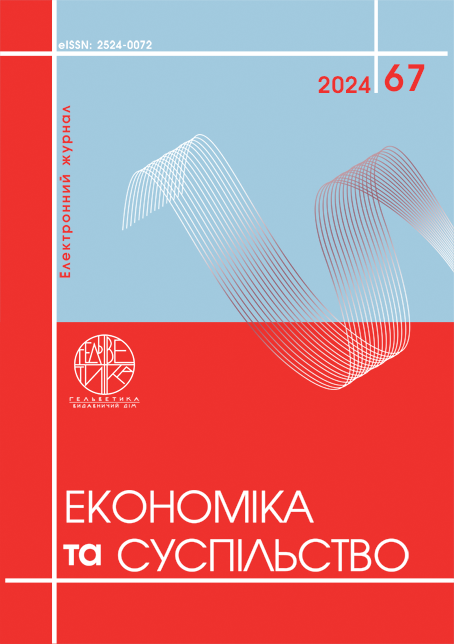INFORMATION TECHNOLOGY AS A TOOL OF STRATEGIC INNOVATION MANAGEMENT IN THE ORGANIZATION
Abstract
This topic covers two important aspects of modern management: the use of innovation as a key factor in the organization's development and the role of information technology in increasing management efficiency. It allows you to study the impact of new technologies on management processes, consider how innovations can contribute to the achievement of the company's strategic goals, and increase its competitiveness through the optimization of business processes. In today's conditions of global digitalization, information technologies play a key role in the process of strategic management of innovations in organizations. The use of IT solutions allows to increase the efficiency of planning, coordination and control of innovative projects, and also provides flexibility in making management decisions. Information technologies contribute to the reduction of risks in the implementation of innovative strategies and improve the organization's ability to quickly adapt to changes in market conditions. Particular attention is paid to such tools as project management systems, data analytics, cloud technologies and artificial intelligence, which allow creating effective innovation ecosystems, integrating all stages of innovation process management. This topic examines the main approaches to the implementation of information technologies in the strategic management of innovations, as well as their impact on achieving competitive advantages and long-term development of organizations. The role of information technologies (IT) in modern organizations has expanded significantly, becoming a key factor in the strategic management of innovation. This research focuses on how IT solutions support and enhance innovation processes within organizations. By leveraging advanced IT systems, companies can streamline operations, optimize decision-making processes, and create a more agile environment that fosters innovation. The study also explores the integration of IT tools into strategic management practices, highlighting their impact on innovation efficiency, organizational adaptability, and competitiveness. The effective use of IT allows organizations to predict trends, manage risks, and create sustainable growth through continuous innovation.
References
Ареф’єва О., Пілецька С., Лістрова М. Формування конкурентної стратегії підприємства в системі антикризового управління. Економіка та суспільство. 2022. № 43. DOI: https://doi.org/10.32782/2524-0072/2022-43-35 (дата звернення: 03.08.2024).
Витвицька О., Суворова С., Корюгін А. Вплив цифрового маркетингу на розвиток підприємництва в умовах війни. Економіка та суспільство. 2022. № 40. URL: https://economyandsociety.in.ua/index.php/journal/article/view/1518 (дата звернення: 03.08.2024).
Камінський Л.Р. Методичні підходи до дослідження інноваційної діяльності підприємств. Економіка та суспільство. 2024. № 59.
Ковальчук Т., Загарій В. Інноваційні стратегії міжнародної конкурентоспроможності підприємств України. Економіка та суспільство. 2024. № 59.
Орел А.М., Дяченко В.В. Особливості фінансової системи в економічних процесах країни. Управління змінами та інновації. 2023. № 6. С. 25–33.
Орел В.М. Вплив глобалізації на економічні системи та виникнення між ними конкуренції. Актуальні проблеми інноваційної економіки. 2017. № 3. С. 52–58.
Стратегія розвитку сфери інноваційної діяльності на період до 2030 року: Розпорядження Кабінету Міністрів України від 10.07.2019 р. № 526-р. URL: https://zakon.rada.gov.ua/laws
Паламарчук Г. М., Шевченко М. М. Організаційні інновації як чинник підвищення конкурентоспроможності економіки. Проблеми науки. 2017. № 2. С. 2–8.
Aref'eva O., Piletska S. and Listrova M. (2022) Formuvannya konkurentnoyi stratehiyi pidpryyemstva v systemi antykryzovoho upravlinnya [Formation of the competitive strategy of the enterprise in the anti-crisis management system]. Ekonomika ta suspil'stvo-Economy and society, vol. 43. Available at: http://www.economyandsociety.in.ua/index.php/journal/article/view/1721/1658
Vytvyc'ka O., Suvorova S. and Korjugin A. (2022) Vplyv tsyfrovoho marketynhu na rozvytok pidpryyemnytstva v umovakh viyny [The influence of digital marketing on the development of entrepreneurship in the conditions of war]. Ekonomika ta suspil'stvo-Economy and society, vol. 40. Available at: https://economyandsociety.in.ua/index.php/journal/article/view/1518
Kaminsky L.R. (2024) Metodychni pidkhody do doslidzhennya innovatsiynoyi diyalʹnosti pidpryyemstv [Methodical approaches to the research of innovative activities of enterprises]. Ekonomika ta suspil'stvo – Economy and society, vol. (59).
Kovalchuk T. and Zaghariy V. (2024) Innovatsiyni stratehiyi mizhnarodnoyi konkurentospromozhnosti pidpryyemstv Ukrayiny [Innovative strategies of international competitiveness of Ukrainian enterprises]. Ekonomika ta suspil'stvo – Economy and society, vol. (59).
Orel A.M. and Dyachenko V.V. (2023) Osoblyvosti finansovoyi systemy v ekonomichnykh protsesakh krayiny. Upravlinnya zminamy ta innovatsiyi [Peculiarities of the financial system in the country's economic processes]. Upravlinnya zminamy ta innovatsiyi-Change management and innovation, no. 6, pp. 25–33. Available at:http://cmi.politehnica.zp.ua/index.php/journal/article/view/75
Orel V.M. (2017) Vplyv hlobalizatsiyi na ekonomichni systemy ta vynyknennya mizh nymy konkurentsiyi [The impact of globalization on economic systems and the emergence of competition between them]. Aktualʹni problemy innovatsiynoyi ekonomiky – Actual problems of innovative economy, no. 3, pp. 52–58.
Cabinet of Ministers of Ukraine (2019) Strategy for the development of the sphere of innovative activity for the period up to 2030. Available at: https://zakon.rada.gov.ua/laws/show
Palamarchuk H.M. and Shevchenko M.M. (2017) Orhanizatsiyni innovatsiyi yak chynnyk pidvyshchennya konkurentospromozhnosti ekonomiky [Organizational innovations as a factor in increasing the competitiveness of the economy]. Problemy nauky – Problems of science, no. 2, рр. 2–8.

This work is licensed under a Creative Commons Attribution 4.0 International License.


